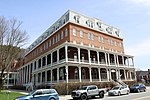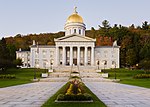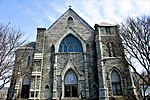Montpelier ( mont-PEEL-yer) is the capital of the U.S. state of Vermont and the county seat of Washington County. The site of Vermont's state government, it is the least populous state capital in the United States. As of the 2020 census, the population was 8,074. However, the daytime population grows to about 21,000, due to the large number of jobs within city limits. The Vermont College of Fine Arts is located in the municipality. It was named after Montpellier, a city in the south of France.Montpelier was chartered as a town by proprietors from Massachusetts and western Vermont on August 14, 1781, and the Town of Montpelier was granted municipal powers by the "Governor, Council and General Assembly of the Freemen of the State of Vermont". The first permanent settlement began in May 1787, and a town meeting was established in 1791. The city received a French name because the Franco-American alliance during the Revolutionary War had sparked widespread Francophilia. Montpelier was selected as state capital in 1805, and citizens of the town donated funds to build the first state house. The legislature chartered the City of Montpelier in 1894, and it was organized at a town meeting the next year.Montpelier is in the north-central area of the state. The Winooski River flows by the south side of the city, passing by the state house and continuing northwest into Chittenden County. The North Branch River, a tributary of the Winooski, also flows through the city. Flooding is a periodic problem in Montpelier, with three serious floods occurring in 1927, 1992, and 2023. In 1875, fires destroyed 38 buildings in the city, and the commercial area was rebuilt with brick to avoid a repeat of the disaster. The state government contributes to the city's economy, which also relies on insurance and tourism. The insurance industry in Montpelier dates back to the early 19th century. Historically, tradesmen shops and mills along the North Branch also fueled the economy, and sheds for finishing granite from Barre operated along the Winooski. Ski areas are also located near the city.Travelers can reach the city via the Amtrak Montpelier station, which is located 2 miles west of the downtown area and offers regular service on the Vermonter train. Private planes can also use the nearby Edward F. Knapp State Airport in Berlin, Vermont, but the closest commercial air service is via the Patrick Leahy Burlington International Airport 35 miles (56 km) to the northwest.







